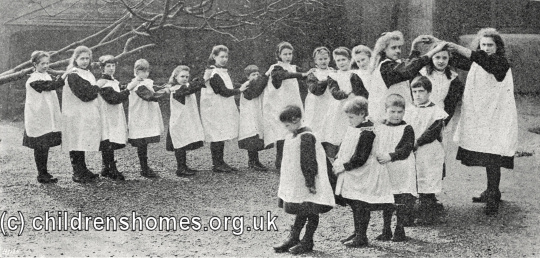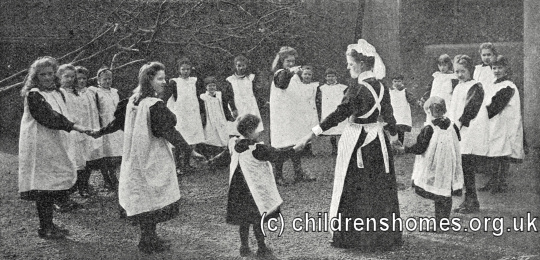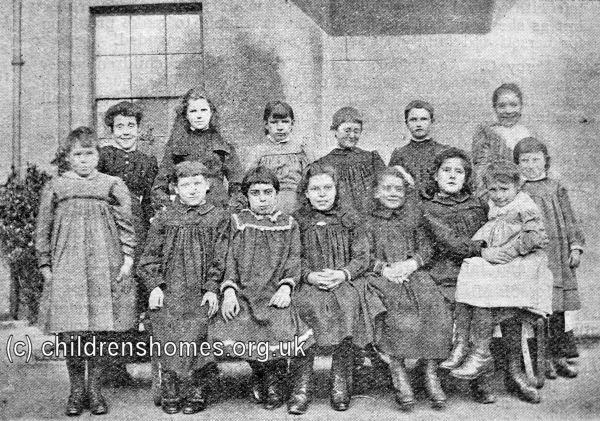Industrial Home for Girls, Brighton, Sussex
The Industrial Home for Girls was founded in 1854 at Egremont Place, Brighton. Its object was 'to provide a home for poor girls and orphans of good character.' The home could accommodate up to 30 girls aged 7 to 14, who were given training in needlework, cooking, housework and laundry work to equip them for a future in domestic service. A payment of £2. 10s. per quarter was required for Brighton girls, or £3 if from other towns. Those being admitted also had to be provided with an outfit of clothes and certificates of birth and good health.

Former Brighton Industrial Home for Girls, Egremont Place, 2018. © Peter Higginbotham
On January 1st, 1894, the home was taken over by the Waifs and Strays Society but was left to continue along its existing lines.

Brighton Industrial Home girls playing 'oranges and lemons', c.1900. © Peter Higginbotham

Brighton Industrial Home girls playing 'ring a ring o'roses', c.1900. © Peter Higginbotham

Brighton Industrial Home, c.1905. © Peter Higginbotham

Brighton Industrial Home, c.1905. © Peter Higginbotham

Brighton Industrial Home, c.1911. © Peter Higginbotham
The quality of the girls' needlework was well regarded and items were sold at the occasional 'Fancy Fairs' held at the home. In the First World War, the girls also made handkerchieves and scarves for the troops.
In 1921, the Brighton girls made a holiday exchange visit with the counterparts at the St Hilda's Home in Beckenham. All their luggage was packed in a lrge van for the trip.

Brighton girls setting out for Beckenham, 1921. © Peter Higginbotham
The Egremont Place premises were proving increasingly unsatisfactory, so the home was closed towards the end of 1921 and the girls temporarily placed elsewhere until a better house became available. This eventually happened in 1926 when the new St Gabriel's Home was opened at Wellington Road, Brighton.
The Egremont Place property is now in private residential use.
Records
Note: many repositories impose a closure period of up to 100 years for records identifying individuals. Before travelling a long distance, always check that the records you want to consult will be available.
- Index of the Society's first 30,000 children's case files ordered by surname.
- Index of the Society's first 30,000 children's case files ordered by date of birth.
- The Children's Society Records and Archive Centre is at Unit 25, Springfield House, 5 Tyssen Street, London E8 2LZ (email: archives@childrenssociety.org.uk). Files for children admitted to its homes after September 1926 were microfilmed in the 1980s and the originals destroyed. Some post-1926 files had already been damaged or destroyed during a flood. The Society's Post-Adoption and Care Service provides access to records, information, advice, birth record counselling, tracing and intermediary service for people who were in care or adopted through the Society.
- The Society has produced detailed catalogues of its records relating to disabled children, and of records relating to the Children's Union (a fundraising body mostly supported from the contributions of children).
Bibliography
- Bowder, Bill Children First: a photo-history of England's children in need (1980, Mowbray)
- Church of England Waifs and Strays' Society [Rudolfe, Edward de Montjoie] The First Forty Years: a chronicle of the Church of England Waifs and Strays' Society 1881-1920 (1922, Church of England Waifs and Strays' Society / S.P.C.K.)
- Higginbotham, Peter Children's Homes: A History of Institutional Care for Britain's Young (2017, Pen & Sword)
- Morris, Lester The Violets Are Mine: Tales of an Unwanted Orphan (2011, Xlibris Corporation) — memoir of a boy growing up in several of the Society's homes (Princes Risborough, Ashdon, Hunstanton, Leicester) in the 1940s and 50s.
- Rudolf, Mildred de Montjoie Everybody's Children: the story of the Church of England Children's Society 1921-1948 (1950, OUP)
- Stroud, John Thirteen Penny Stamps: the story of the Church of England Children's Society (Waifs and Strays) from 1881 to the 1970s (1971, Hodder and Stoughton)
Links
- Hidden Lives Revealed — the story of the children who were in the care of The Children's Society in late Victorian and early 20th Century Britain.
- The Children's Society
Except where indicated, this page () © Peter Higginbotham. Contents may not be reproduced without permission.


